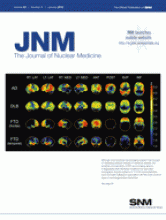In the June 2011 issue of The Journal of Nuclear Medicine, Sathekge et al. (1) examined the reliability of 18F-FDG PET/CT in differentiating tuberculosis-infected HIV patients who respond to anti-Koch therapy from those who do not respond. The authors reported that at 4 mo there was an excellent sensitivity, specificity, and negative predictive value and a modest positive predictive value. Such an observation is important, because shifting to alternative regimens is a crucial and defining step in patients who have multidrug-resistant and extensively drug-resistant tuberculosis. Both these entities pose a significant challenge to health care, and their early definitive identification will prove extremely useful in the management of tuberculosis. Hence, such studies need to be increasingly undertaken, and the countries of the developing world, where the prevalence of this disease is relatively high, can play an active role. The paper of Sathekge was a highlight of the June issue, and I would like to congratulate the authors on their work. In our own initial experience with a few patients (unpublished data; 2010–2011), a significant response was documented as early as 6 wk after treatment initiation. For a standard case of tuberculosis, the most common regimens adopted upfront after diagnosis are either isoniazid, rifampicin, ethambutol, and pyrazinamide daily for 2 mo, followed by 4 mo of isoniazid and rifampicin, or streptomycin, isoniazid, rifampicin, and pyrazinamide daily for 2 mo, followed by 4 mo of isoniazid and rifampicin. It can be presumed that if 18F-FDG PET/CT could reliably differentiate responders from nonresponders at 2 mo, a time point at which physicians choose a battery of tests (e.g., assessment of sputum, smears, and cultures in addition to clinical and radiologic assessment) to detect treatment response or failure, 18F-FDG PET/CT could be used as an important objective parameter in the management of tuberculosis. In line with the observations of the authors, our preliminary experience suggests that the change in 18F-FDG uptake after initiation of anti-Koch therapy in tuberculosis is certainly not so dramatic as is observed in patients with tumors such as gastrointestinal stromal tumors on imatinib therapy, and thus there is a need to generate appropriate PET metrics in subsequent studies to distinguish responders from nonresponders.
The role of 18F-FDG PET/CT in monitoring therapeutic efficacy has been relatively more successful in several systemic inflammatory conditions and granulomatous diseases such as sarcoidosis (2) and vasculitis (3), for which the initiation of steroid therapy normalizes 18F-FDG uptake in disease foci and indicates clinical response simultaneously with or even before normalization of laboratory data. Several other infectious inflammatory conditions are being examined, and multiple anecdotal case reports and series in the literature document the utility of this modality in monitoring the efficacy of antiinfective therapy. One would expect that these investigations will have a positive outcome and that this promising molecular imaging technique will find a useful role in clinically challenging patients with this group of disorders.
Footnotes
Published online Nov. 7, 2011.
- © 2012 by the Society of Nuclear Medicine, Inc.







